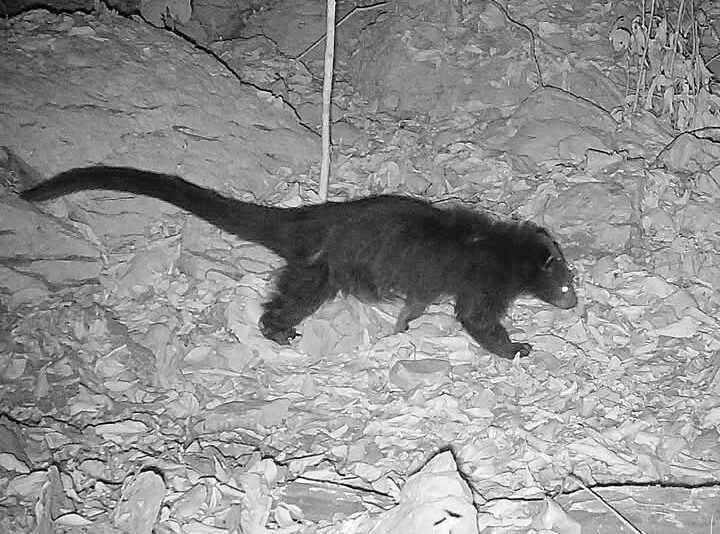Shillong, April 2: Conservationists are thrilled to see a rare Binturong captured on a camera trap set up by the Wildlife Trust of India’s Garo Green Spine project team in the Narang Wari Village Reserve Forest (VRF), located in the buffer zone of Balpakram National Park.
The 350-hectare Narang Wari Village Reserve Forest was designated as a Village Reserve Forest (VRF) under the Garo Hills Autonomous District Council (GHADC), providing crucial habitat for diverse wildlife. The VRF was designated last year.
The Binturong is the largest member of the civet family (Viverridae) and inhabits a wide range from northeast India to Southeast Asia. It leads a primarily arboreal lifestyle, feasting on fruits—especially figs—while occasionally consuming leaves, birds, carrion, and fish.
Beyond their unique appearance, binturongs play a vital role in forest regeneration, aiding in seed dispersal and supporting the survival of many other species. Categorised as Vulnerable under the IUCN Red List, this species faces threats from habitat loss, degradation, snaring, the pet trade, and its use in traditional medicine across its distribution range.
The Garo Hills are part of the larger Meghalaya elephant landscape that includes the Garo Hills Elephant Reserve spread over 3500 sq km, the Nokrek Biosphere Reserve, three Protected Areas (Balpakram NP, Siju WLS and Nokrek NP) and five elephant corridors, together supporting about 800-1000 elephants.
Only 7-8% of the forested area in the Garo Hills is under the control of the Meghalaya Forest Department; the remaining area is owned by local communities under the management and jurisdiction of the Garo Hills Autonomous District Council (GHADC).
Wildlife Trust of India (WTI), with the support of World Land Trust (WLT), HCL Foundation and Dr. Reddy’s Laboratories in partnership with the GHADC and the state forest department, have been working with these communities for almost two decades now. “Our overarching aim is to connect the fragmented forest patches located between the West Garo Hills and Nokrek National Park to establish an unbroken wilderness link with Balpakram National Park. This network of forest patches forms the backbone of the region’s biodiversity and has been designated the Garo Green Spine,” a WTI official said.
The creation of Village Reserve Forests(VRF) is based on community participatory discussions and resolutions from villages on incentive schemes for the designation of areas for VRFs, thus bringing in more areas under protection.
As part of the Wild Lands division, the Garo Green Spine Conservation project aims to protect the canopies, corridors and catchments of the Garo Green Spine.
The idea is to increase the total area under conservation by: (a) legally notifying larger lands for wildlife conservation as Village Reserve Forests (VRF), (b) restoring jhummed fallow lands, (c) sensitising local communities about the importance and benefits of wildlife conservation through campaigns, (d) optimising social and biodiversity benefits by strengthening livelihood and employment opportunities, (e) reducing people’s dependency on forests through the use of fuel efficient stoves on a pilot basis to reduce fuel wood extraction, and (f) sharing experiences, learnings and success models with the public through workshops and meetings.
Also Read: Meghalaya’s Ryndia and Handloom Products receive prestigious GI Tag
Also Watch
Find latest news from every corner of Northeast India at hubnetwork.in, your online source for breaking news, video coverage.
Also, Follow us on-
Twitter-twitter.com/nemediahub
Youtube channel- www.youtube.com/@NortheastMediaHub2020
Instagram- www.instagram.com/ne_media_hub
Download our app from playstore – Northeast Media Hub





